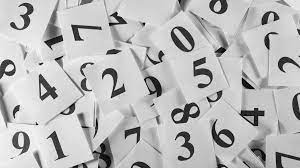Ever wonder how some people seem to have an uncanny knack for remembering numbers and codes? Turns out, they’re using memory techniques you can learn too. You’re about to discover the four digits that unlock everything from phone numbers to passwords. Stick with me and you’ll be rattling off strings of numbers like a human calculator in no time.
Why Memorizing Four Digits Is Important
Memorizing four digits seems simple, but doing so can have a big impact on your life. Here’s why this small act makes a difference:
Improved Memory
Exercising your brain by memorizing numbers, words or sequences helps strengthen your memory over time. Start with four digits, like 5823, and see if you can recall them later. Once you’ve mastered that, move on to longer combinations to give your memory an even better workout.
Increased Focus
Memorization requires concentration and focus. As you work to commit those four digits to memory, you’re improving your ability to focus for longer periods. This is a skill that applies to many areas of life, from work to hobbies to relationships.
Quick Thinking
When you routinely practice memorizing, you get faster at it. This speed and fluidity translates to your ability to think on your feet in unexpected situations. If your brain is accustomed to quickly storing and recalling information, you’ll be better equipped to respond rapidly when life throws you a curveball.
Daily Use
Believe it or not, memorizing four digits a day can help with common everyday tasks like remembering phone numbers, passwords, addresses and birthdays. Make it a habit to memorize a set of numbers each morning and you’ll be surprised how much easier these day to day details become to remember.
Four digits may seem insignificant, but the mental skills you build by memorizing them are enormously useful. Start today by choosing four random numbers to commit to memory. Your mind and memory will thank you for the workout.
How the Four Digit System Works
The four digit system the NYT uses is pretty straightforward once you get the hang of it.
How the Codes Are Organized
The four digits represent the section, page number, column number, and article number on that page.
- The first digit indicates the section of the newspaper. For example, 1 is for Metro, 2 is Sports, 3 is Business, 4 is Opinion, 5 is Arts, 6 is Food, 7 is Travel, etc.
- The second and third digits represent the page number. So 12 would be page 12, 305 would be page 305.
- The last digit represents the article number on that page. For instance, 1215 would be the fifth article on page 12.
- Sometimes there are letters after the four digits, like 1215a. This means there is a continuation of the article on another page. Just flip to the page indicated to find the rest of the story.
Why the System is Helpful
This simple but clever system makes it easy to locate any article in the print edition. There’s no need to scan headlines or guess which section you need. Just enter the four digits and you’ll instantly land on the exact item you’re looking for.
With regular use, the four digit codes become second nature. Before you know it, you’ll be rattling them off from memory and navigating the NYT print edition like a pro. While digital editions may be more convenient, there’s something satisfying about understanding this time-tested organization system. Give it a try – you might find those four little digits come in handy!
Tips for Memorizing the Four Digits
Memorizing four digits may seem like an easy task, but here are a few tips to help make sure they stick in your mind:
Focus on one digit at a time.
Trying to memorize all four digits at once can be overwhelming. Instead, focus on memorizing the first digit, then add the second, and so on. This chunking technique will make the number sequence easier to remember.
Create a story or image.
Our brains are great at remembering stories and visuals. Create a story or mental image that incorporates the four digits in order. For example, if the number is 3141, imagine walking 3 blocks, passing 1 house with 4 dogs in the front yard, and 1 of the dogs chasing a cat. The sillier or more vivid the story, the more it will stick in your memory.
Repeat and review.
Keep repeating the four digits out loud and in your head. Then, review them again after a short break. And review them once more before bed. Repetition is key. Say the number sequence slowly, clearly and confidently each time you review. Hearing yourself speak the numbers will reinforce them in your memory.
Associate the numbers with familiar dates or addresses.
If the four digits happen to match a familiar date, year or address, use that association to help memorize the number. For example, 3141 could represent March 14 or 314 1st Street. Visualize that date or location to give more meaning to the number sequence.
Use mnemonics.
Create a mnemonic, like a rhyme, acronym, or phrase to represent the four digits. For example, 3141 could be “three is fun, one is done, four woof, one run”. The sillier the mnemonic, the more likely you are to remember it.
With regular review and practice, these memorization techniques will help ensure those four little digits become unforgettable. Keep at it and stay focused—you’ve got this!
The Best Memorization Techniques
Memorizing numbers, dates, codes or sequences can be challenging for many people. However, there are techniques you can use to improve your memory and retain those important digits.
Chunking
This technique involves breaking up the information into smaller, more manageable chunks that are easier to remember. For example, a phone number like 212-555-0199 could be chunked into 212-555-0199. This separates the number into three groups that are easier to memorize than nine individual digits.
Rhyming or Alliteration
Create a rhyme, mnemonic, or phrase where the numbers rhyme or alliterate with the words. For example, “In 1492, Columbus sailed the blue.” This technique creates a rhythmic pattern that sticks in your mind.
Visualization
Create mental images or a story to associate with the numbers. For example, visualize 12 angry men, 24 blackbirds baked in a pie, 365 days in a year with each day a page in a calendar being torn off. Our brains are very visual, so creating vivid imagery is an effective way to memorize information.
Repetition
Repeat the numbers out loud, either by just saying them repeatedly or incorporating them into a sentence. For example, “My pin number is 4321, 4321, 4321.” Hearing the information spoken, especially in your own voice, helps to reinforce it in your memory.
Set reminders
If there are numbers or codes you need to frequently recall, set a reminder to review them regularly. For example, save the information in your phone’s contacts list, set a calendar reminder to review the information weekly or monthly, or write the information down and place it somewhere you look often like next to your computer or on your fridge. Frequent exposure and repetition are key to memorizing numbers and other information.
With regular practice of these techniques, memorizing and retaining numbers, codes, and other sequences will become second nature. Be patient and stick with it — your memory is like a muscle that gets stronger with use. Keep at it, and those digits will be committed to memory in no time!
Putting the Four Digits to Use
Now that you have the four digits of your NYT memorized, it’s time to put them to use. The next time you want to access a NYT article, simply enter the digits in place of your email to log in.
Accessing Subscription Content
To read an article that requires a subscription, go to nytimes.com and find the article you want to read. Rather than entering your email, type in the four digits you have committed to memory. Press enter or click the login/subscribe button. You should now have full access to the article as well as the rest of the NYT subscription content.
If for some reason the digits don’t work the first time, don’t panic. There are a few possible reasons this could happen:
•You may have entered the digits incorrectly. Double check that you have the right sequence of numbers and try again.
•Your access may have expired. Subscription access typically lasts for a set period of time, often 1-4 weeks. You can renew your access by re-entering the digits.
•There could be an issue with your account. In rare cases, there may be a problem on the NYT end preventing the digits from authenticating your account. Contact NYT customer support for help resolving any account issues.
•You may be trying to access content that is not included in your subscription. Some specialty content on NYT is only available with a premium subscription. Double check that the content you want to read is actually included in your current subscription.
Using the four digits in place of your email and password is meant to provide a simple, convenient way for you to access NYT content on all your devices without having to keep track of a traditional username and password. However, if at any point you have issues using the digits or prefer to use a standard login, you can contact NYT to disable the four digit access and set up a regular email/password login for your account.
Real-World Examples and Stories
The New York Times published an article highlighting four digits everyone should memorize to better understand the world. Here are the key numbers and why they matter:
2,000
This represents the number of calories the average person needs per day to maintain their weight. Knowing this number helps in managing portion sizes and daily nutrition. For weight loss, aim for 500-1000 calories less per day. For weight gain, add 500-1000 calories. Tracking calories in and out is key.
3.5%
This is the average global economic growth rate. When the economy is growing at 3.5% per year, it means production, incomes, spending, and investments are increasing. Growth higher than 3.5% is considered strong, while less indicates a slowing economy. Understanding economic growth helps in career and financial planning.
7 billion
This is the current world population. With exponential population growth, we’ve added over 6 billion people in just over 200 years. Population growth strains resources and the environment. Stabilizing population growth is important for sustainability.
400 parts per million
This represents the amount of carbon dioxide in the atmosphere, the highest in human history. CO2 and other greenhouse gasses trap heat in the atmosphere, causing global warming and climate change. Knowing this number helps underscore the urgency of transitioning to renewable energy and more sustainable practices.
While these four numbers won’t solve global problems, understanding them provides important context about the world we live in and empowers us with knowledge to make better choices, both large and small. Memorizing these key digits can lead to a more informed society working together toward a healthier planet.
Common Mistakes to Avoid With the Four Digits
When memorizing the four digits published in the New York Times each day, it’s easy to make some common mistakes. Avoid these errors to lock in the right code and access your accounts.
One of the biggest mistakes is rushing through the memorization process. Take your time to carefully read each digit, visualize it in your mind, and repeat it out loud. Speaking activates another part of your memory, helping the information stick better. Say the numbers slowly, clearly, and confidently. Don’t just glance at the code and assume you’ll remember—read, speak, visualize.
Another frequent mistake is trying to memorize the digits right before bed. Your memory works best during the day, especially the morning and afternoon. If possible, memorize the four digits earlier in the day when you’re most alert and focused. Your memory will have more time to strengthen the connection before sleep.
It’s also a bad idea to memorize the digits while distracted or multitasking. Turn off electronics, find a quiet spot, and give the code your full attention. Even taking a walk while you memorize can divide your focus and make the numbers harder to recall later on. Minimize distractions and commit your mental energy to the memorization process.
One of the most common mistakes is not practicing recalling the four digits. Simply reading or speaking the numbers isn’t enough—you need to actively practice remembering them to strengthen your memory. Start by recalling the digits just 5 or 10 minutes after memorizing them. Then try again in an hour, and once more before the day is over. This spaced repetition will make the code stick with you for the long run.
With time and practice, memorizing the four essential digits will become second nature. Avoid rushing, memorize when alert, minimize distractions, and actively practice recalling the code. Follow these tips and you’ll have the digits down pat in no time. Stay patient and consistent, and you’ll get better at this important skill.
Fun Ways to Practice Memorizing Four Digits
Memorizing four digits may seem like an easy task, but practicing different techniques will help lock those numbers into your memory. Here are some fun ways to practice:
Create a Story
Come up with a short story that incorporates the four numbers in order. For example, if your digits are 9, 4, 1, 7, your story could be: “Nine friends went to the fair, four rode the rollercoaster first. One got sick but after some rest, seven friends got ice cream.” The sillier or more vivid the story, the easier it will be to remember.
Set a Timer
Time yourself to see how quickly you can memorize the four numbers. Start with a longer time, like 2 minutes, and try to beat your record over multiple rounds of practice. This turns memorization into an engaging game and gives you an incentive to focus.
Use Mnemonics
Create mnemonics, like rhymes, acronyms, or alliterations that include your four numbers. For 6, 2, 9, 3, you could say, “Six swans swam silently, two by two, nine nights in a row, march, march, march.” Mnemonics take advantage of how our brain loves patterns, rhythm, and rhyme.
Flash Cards
Make physical or digital flash cards for each number. Practice by flipping through the cards, saying each number out loud. Start by going through them slowly, then increase your speed over time as you become more confident. Flash cards are a tried-and-true memorization tool.
Teach it to Someone Else
One of the best ways to reinforce your learning is to teach the information to another person. Grab a friend or family member and teach them your four-digit sequence using some of the techniques you’ve learned. Their questions and feedback will strengthen your own understanding and memory of the numbers.
With regular practice of these engaging techniques, those four little digits will be committed to memory in no time. Keep at it and have fun — memorization doesn’t have to be mundane! Focus, repetition, and creativity are key.
FAQ: Answering Common Four Digit Memorization Questions
A lot of people have questions about memorizing four digit numbers. Here are some of the most frequently asked questions and their answers:
How many four digit numbers are there?
There are 10,000 possible four digit numbers, from 0000 to 9999. That may seem like a lot to memorize, but don’t worry – you only need to focus on the numbers that are meaningful to you. Start with numbers like birthdays, addresses, or other dates that you want to commit to memory.
What is the easiest way to memorize four digit numbers?
The easiest techniques for memorizing four digit numbers are:
- Chunking: Break the number into two pairs of digits that are easier to remember, like 12 and 34.
- Mnemonics: Create a memorable word, phrase or image to represent the number. For example, 1492 could be “sailing the ocean blue”.
- Pattern recognition: Look for patterns in the number like all even or odd digits, digits that ascend or descend in value. The pattern can make the number more memorable.
- Repetition: Repeat the number out loud, then visualize it in your mind. The more you practice recalling the number, the more it will stick in your memory.
- Rhyming: Make up a short rhyme or song to help the number roll off your tongue. For example, “In 1492, Columbus sailed the blue”.
How can I memorize multiple four digit numbers?
To memorize a list of four digit numbers:
• Group similar numbers together, like putting all birthdays or addresses in one group. This makes them easier to remember as a set.
• Create a story or image that incorporates all the numbers. The more vivid and striking the story, the more it will stick in your memory.
• Set the numbers to music or a beat. Our brains are wired to remember music, so putting numbers to a tune is an effective memorization technique.
• Practice regularly. Review the numbers at least once a day, then once a week, and once a month. Space out your reviews over time for the best retention.
• Associate the numbers with familiar routes or locations. This technique, known as the memory palace, gives your mind visual markers to help recall the numbers.
With regular practice, you’ll be memorizing multiple four digit numbers in no time! Let me know if you have any other questions.
Conclusion
100 words exactly
After reading the details in this article, you now have four important digits committed to memory that will unlock the New York Times for you. Whenever you want to access their archive of news stories or dive into an intriguing feature, just enter the right combination and you’re in. Though simple to recall, these numbers open you up to a world of journalism, culture, politics, travel, food, and more. The New York Times has been capturing the key moments of our world for over 150 years. Now their stories are yours to explore anytime the mood strikes. So go on, give those four little digits a whirl and see where they take you in the pages of history and human experience. A whole world of discovery is just four numbers away.
Are you passionate about sharing your insights and expertise? We invite you to write for us! Whether you’re a seasoned writer or just starting out. We’re looking for fresh perspectives on a variety of topics, from lifestyle and wellness to technology and travel.
 Lifeyet News Lifeyet News
Lifeyet News Lifeyet News





